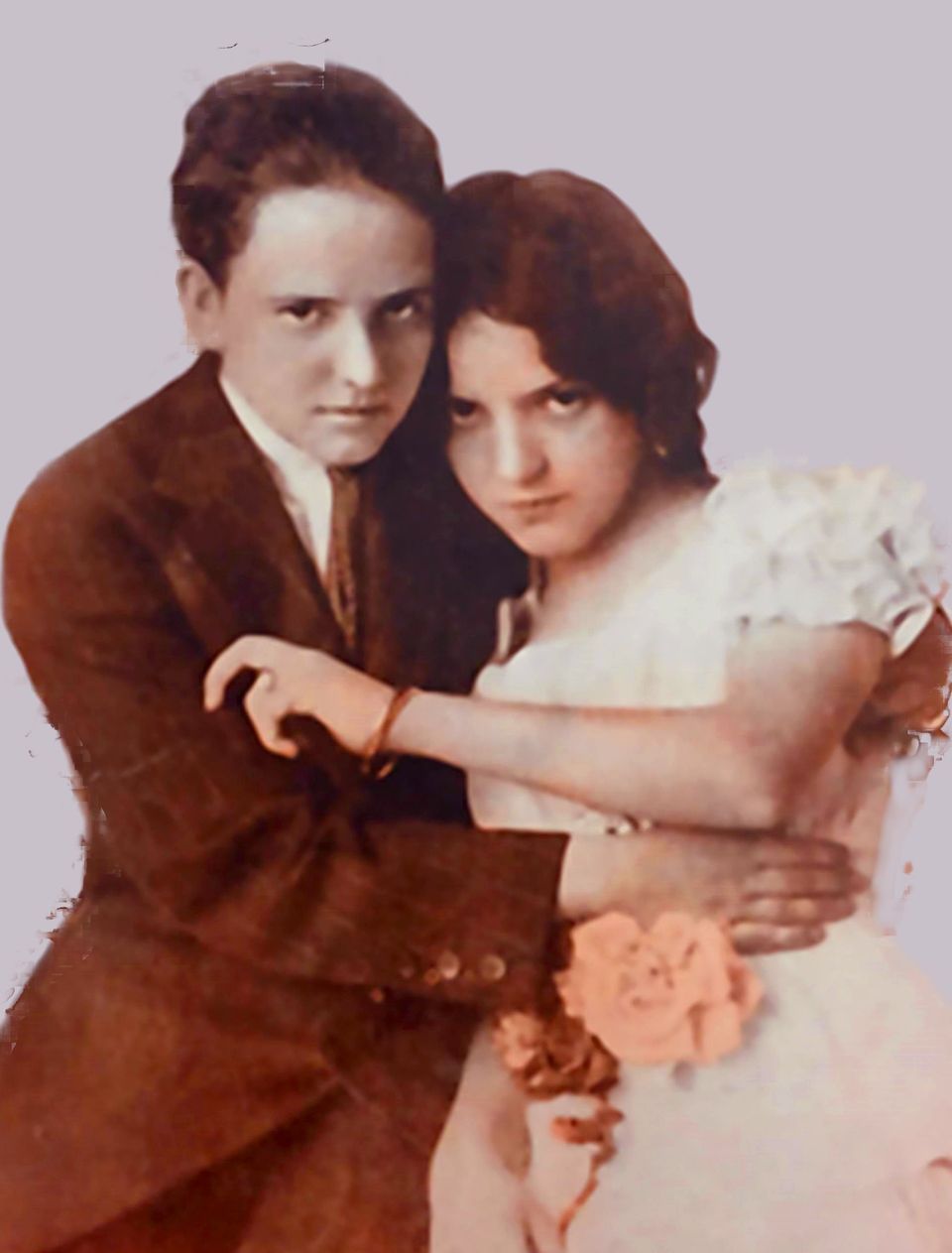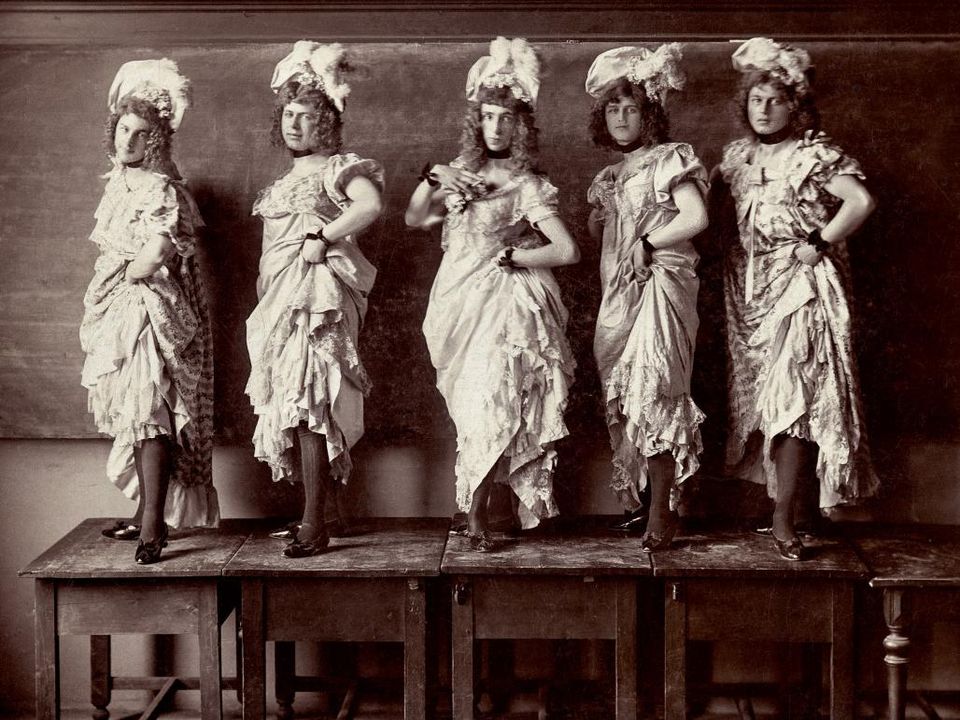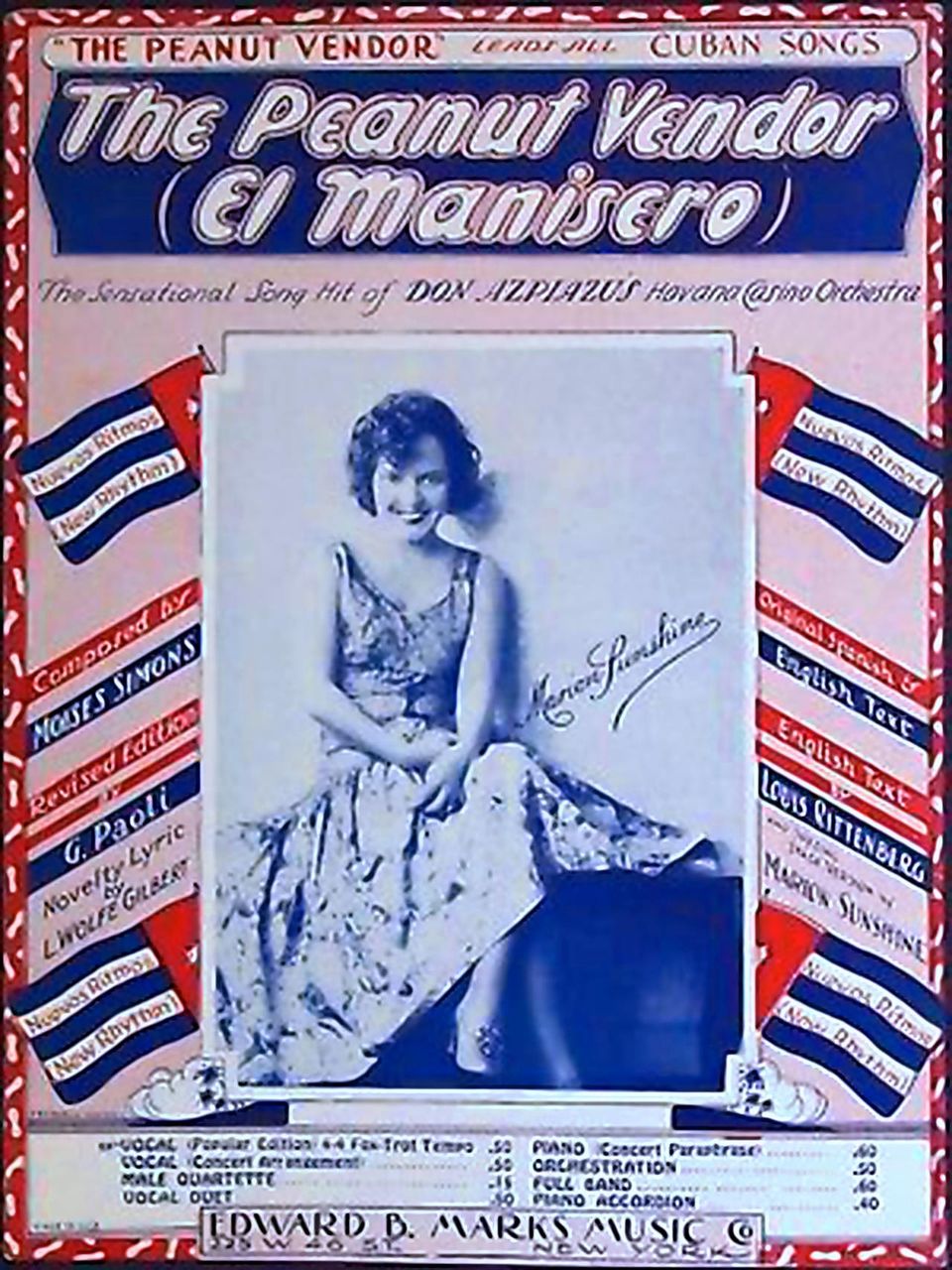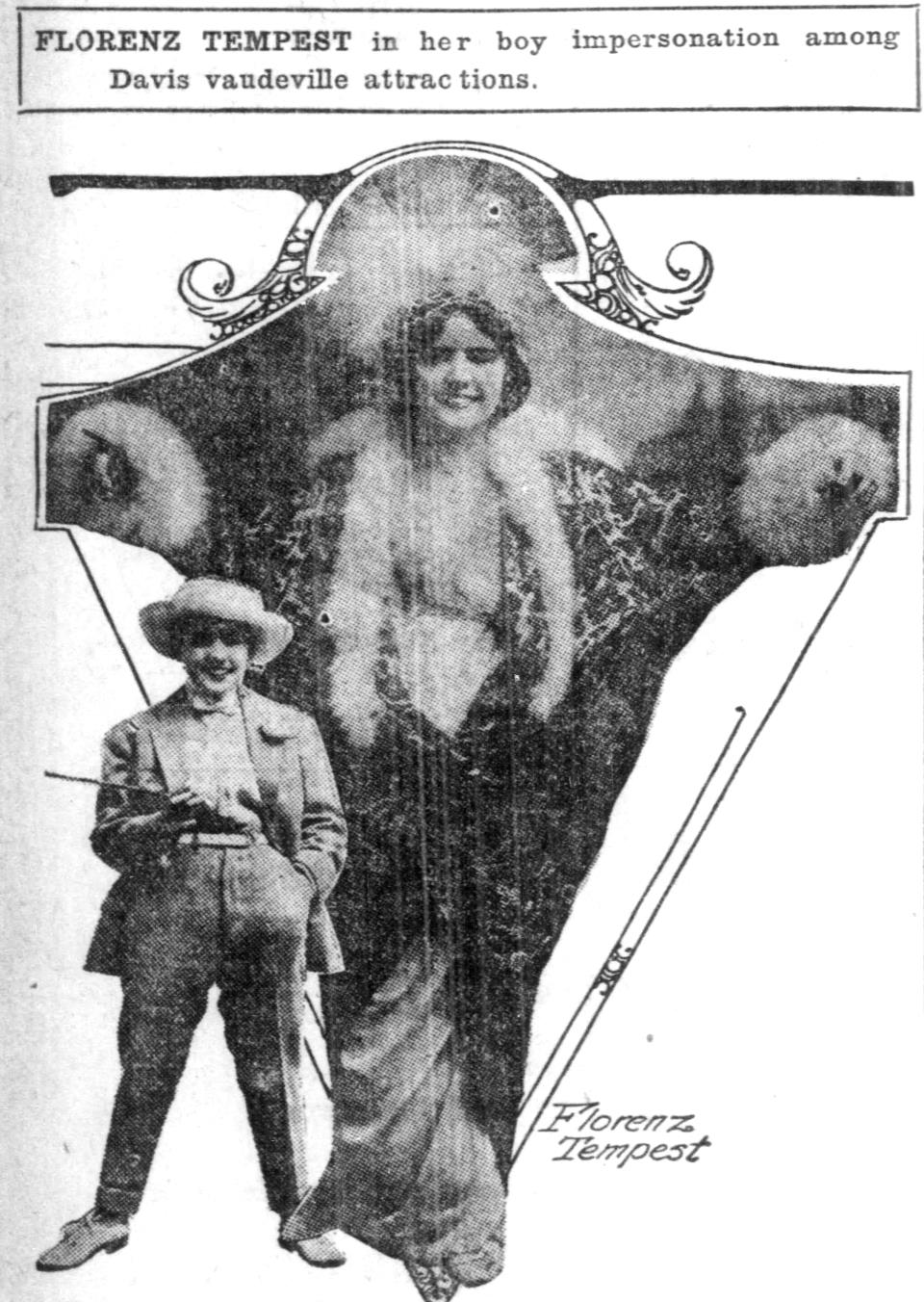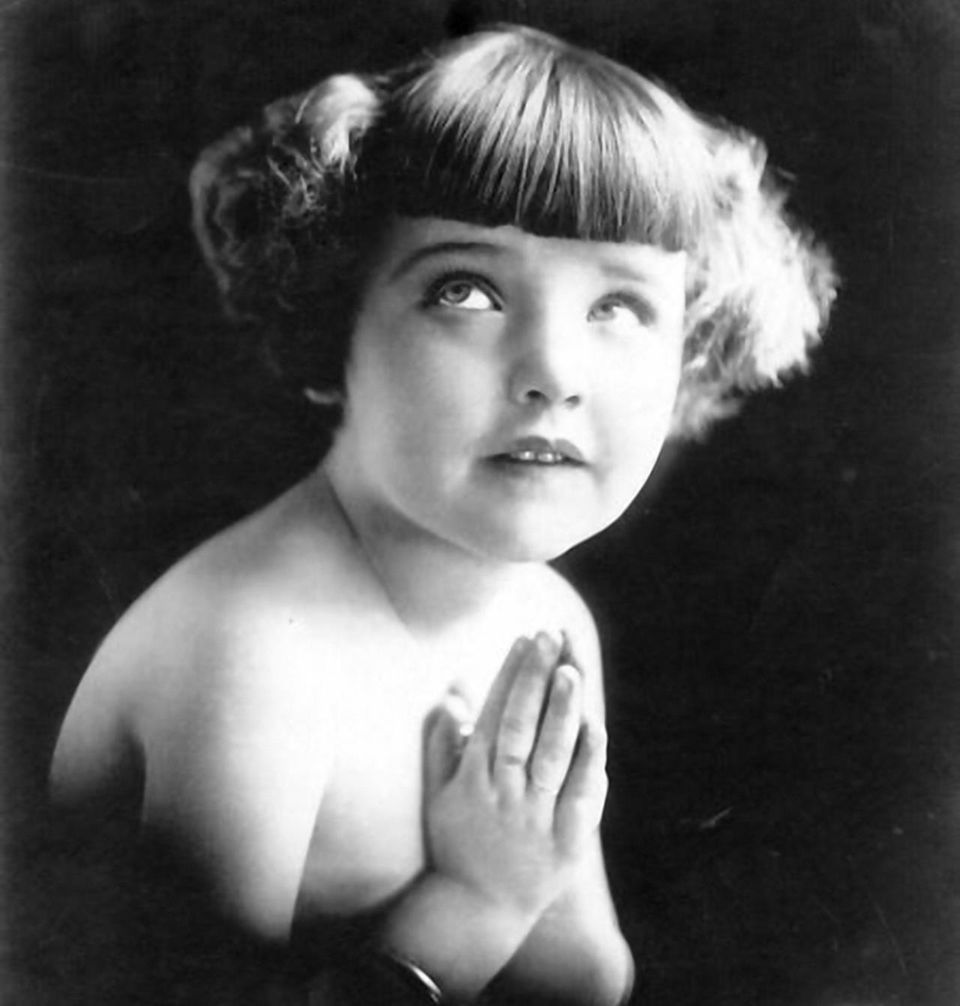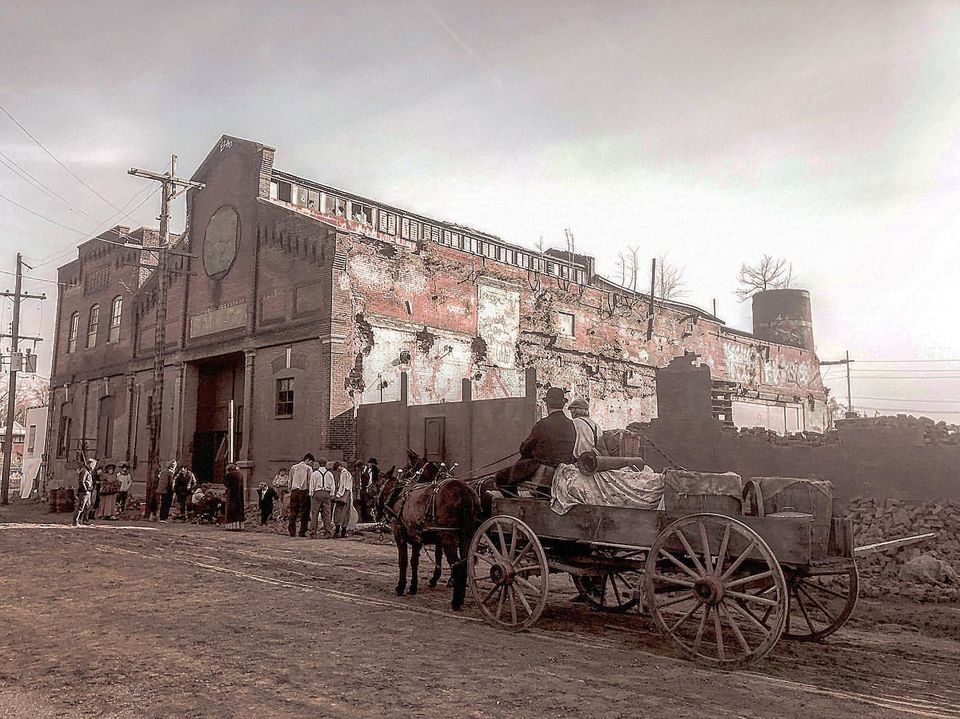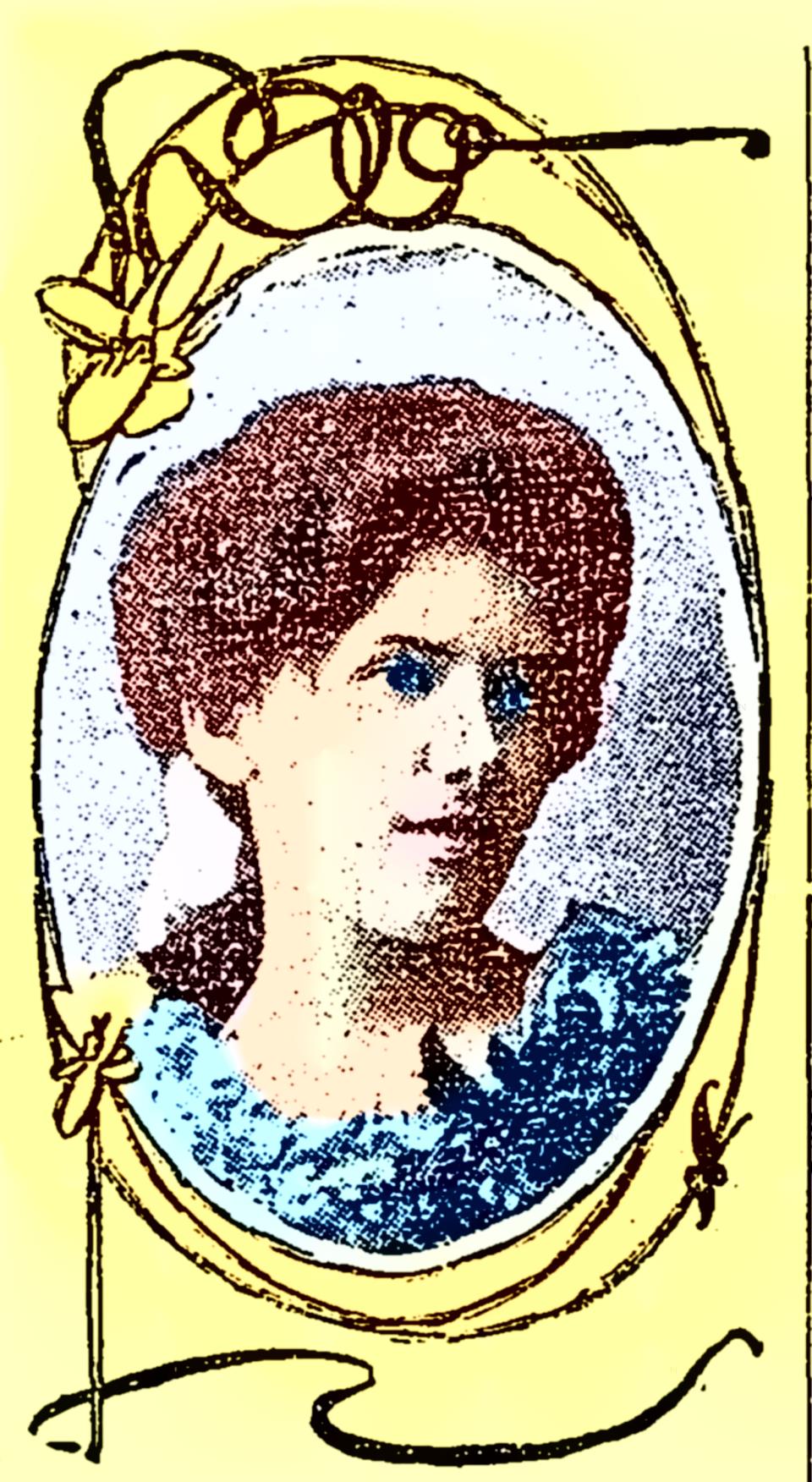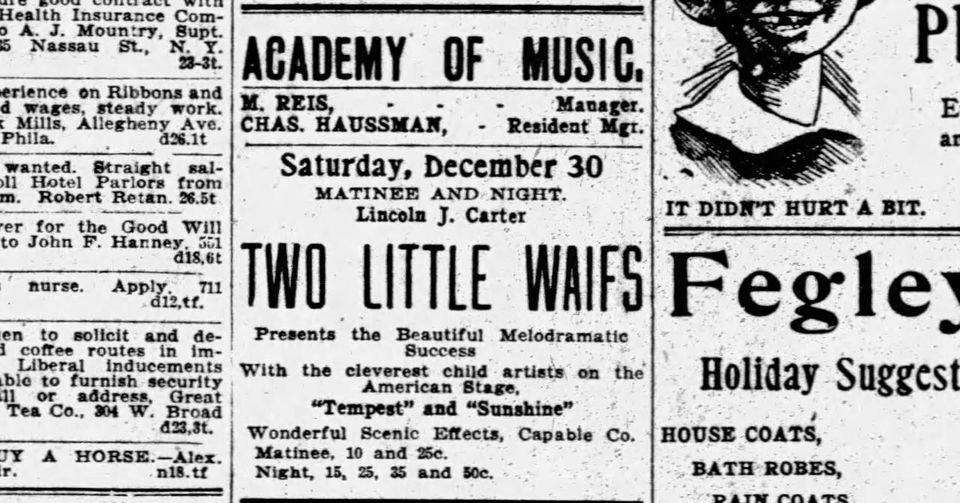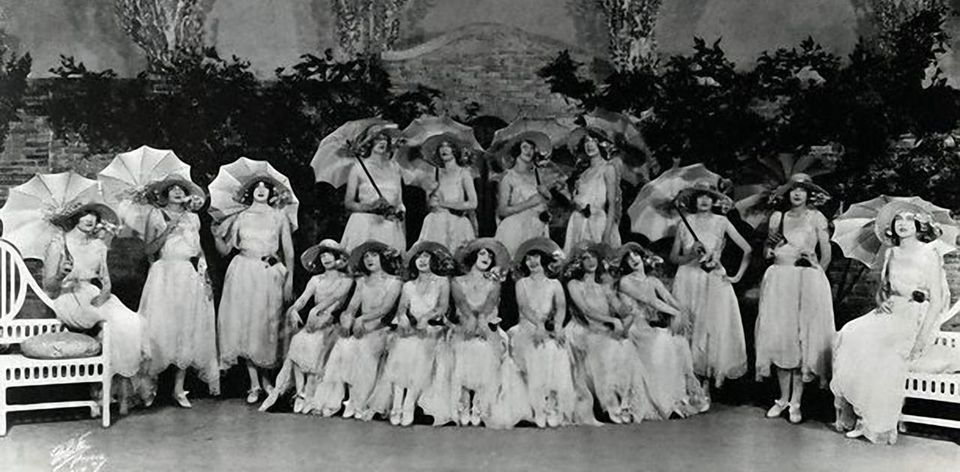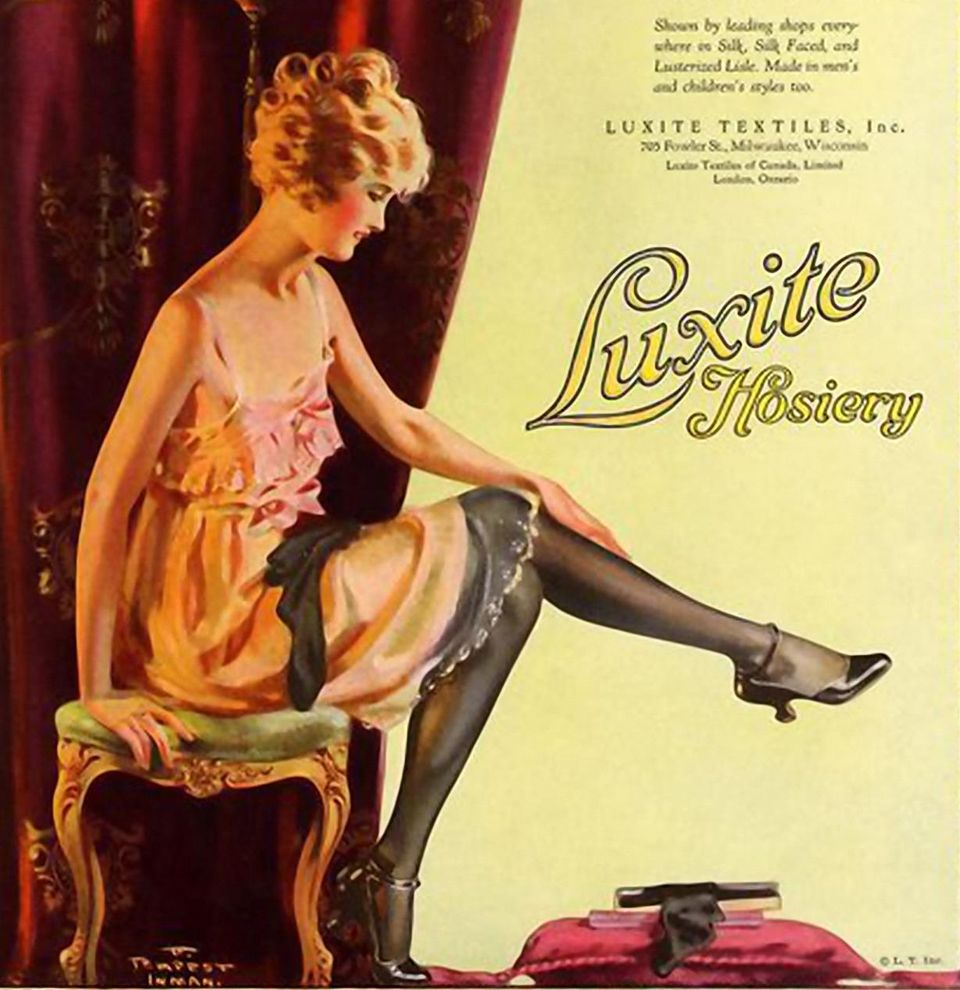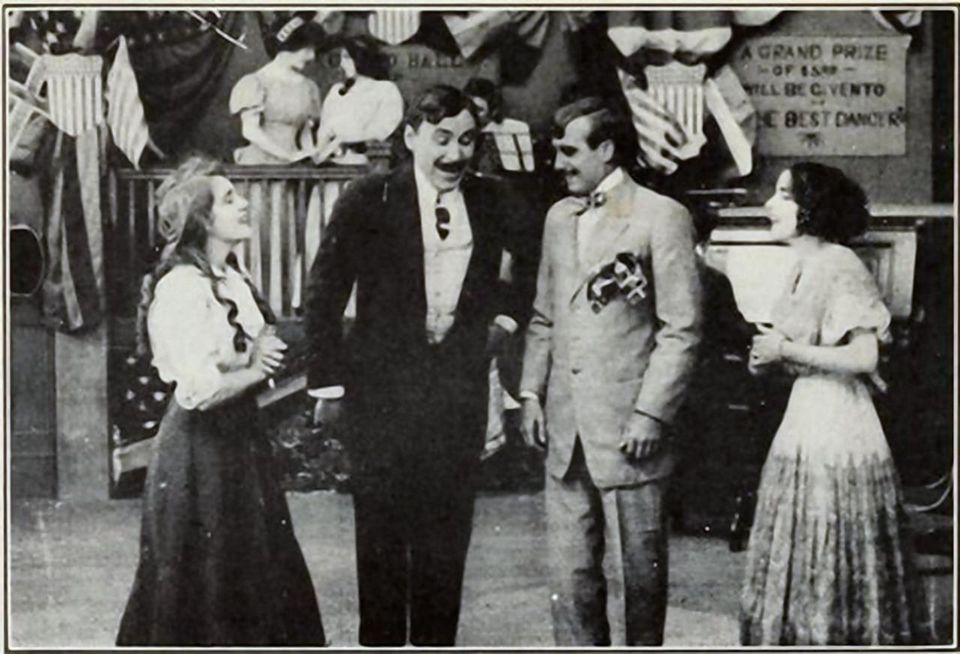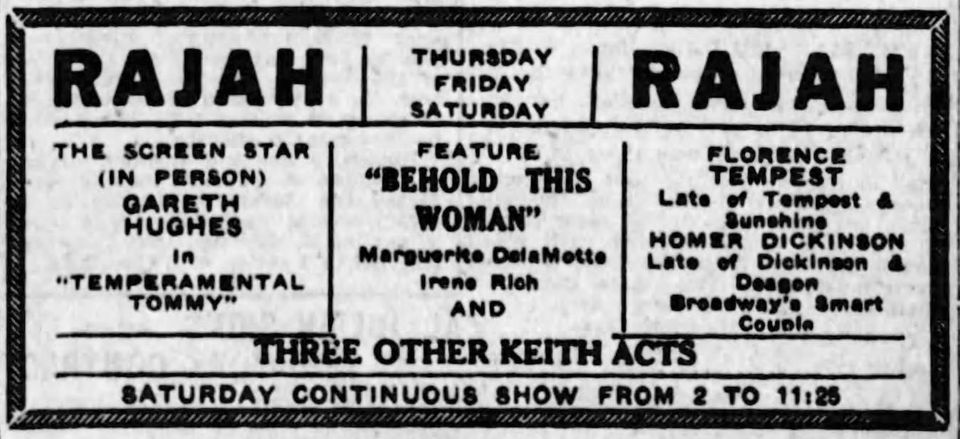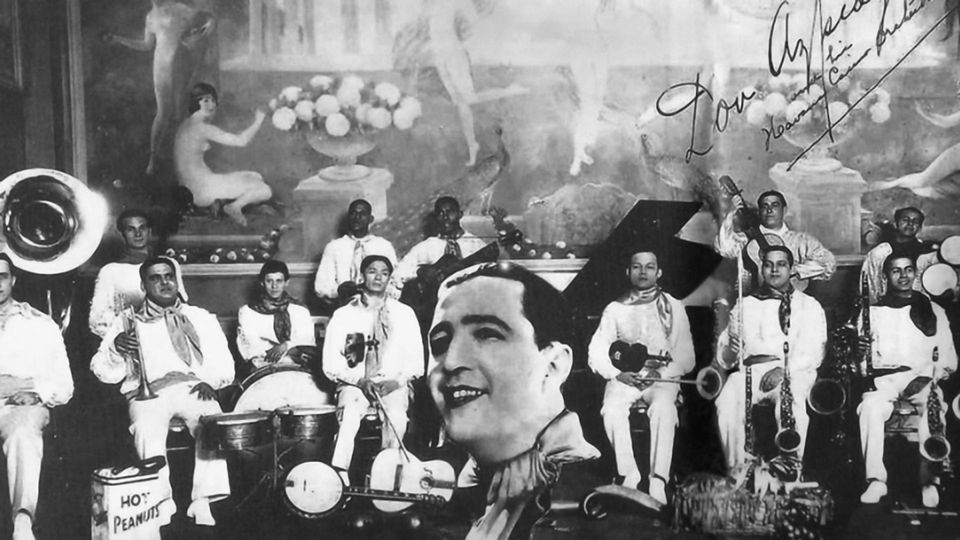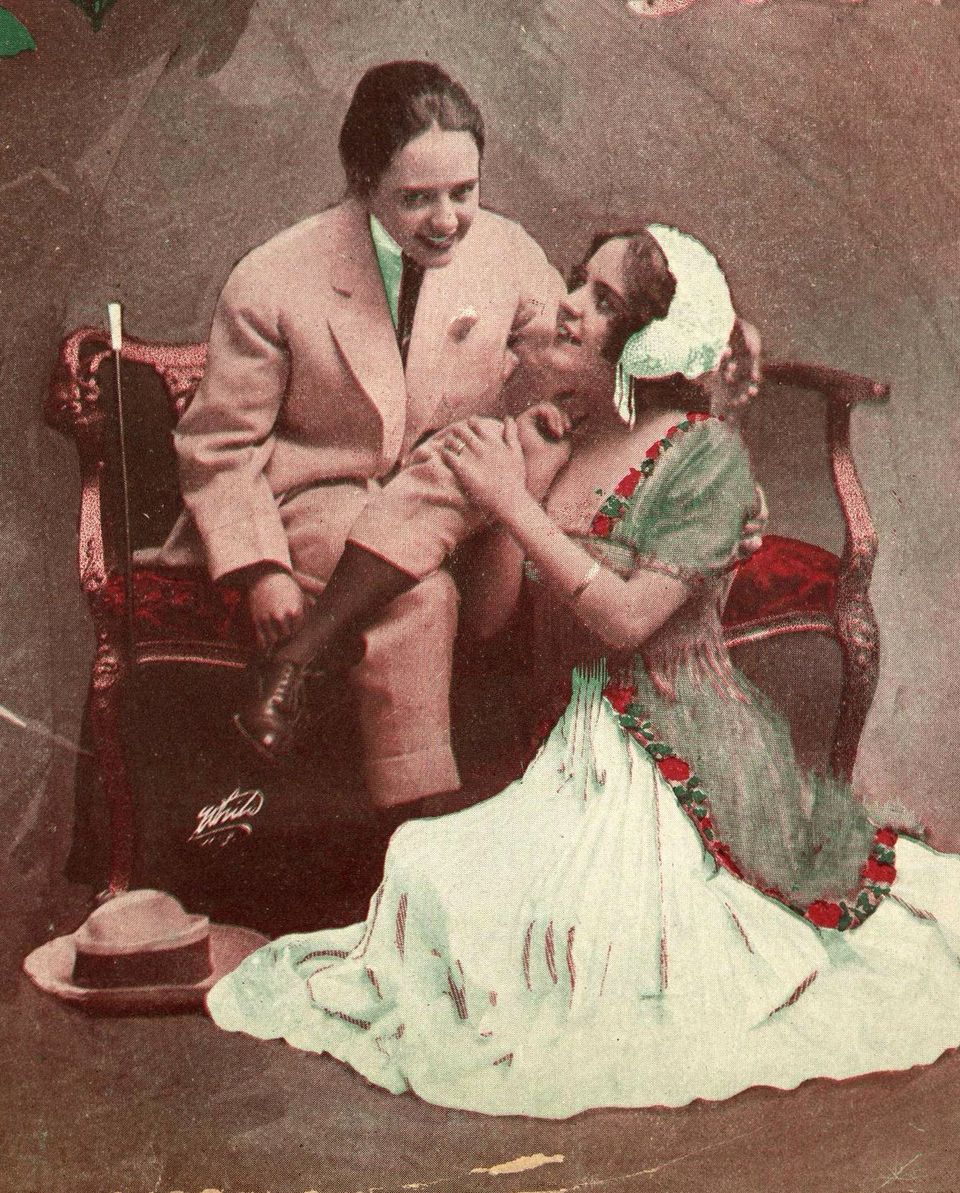TRANS-SISTER SISTERS: Tempest, Sunshine and the Ziegfeld Follies
Thank the Sisters For Drag Shows, Live Stand-Up, Women Wearing Pants, The Mamba, and Pop Latin Music
Our Documentary of Tempest and Sunshine
Look at this photo below from 1910. What do you see?
Do you see a boy and a girl? Do you see
lovers? Or, not? Perhaps you have already figured it out from the title.
So, here it is. Though the couple may love each other, it’s not in a romantic way. They are sisters, Florenze Tempest, and Marion Sunshine, best known as Tempest and Sunshine.
As stage performers, they were a sensation at the turn of the 1900s. Sister Tempest was a transvestite, a cross-dresser, a boy impersonator. And sister Sunshine was a girlie-girl. They sometimes performed as a romantic couple. But the fact that they were sisters did not bring accusations of incest. And more. In many communities where they performed cross-dressing was illegal, including, at that time, San Francisco, yet they never had a run in with the law. So, how in the world did they pull it off?
The short answer is: In performance art, you can do most anything that goes against the norm because it is an enactment. You could act out the role of a murderer on stage and, the police would not be there when the curtain goes down to arrest you. By the way, this is the reason why literature and the arts are so vital. It gives us a safe way to explore human behavior, both good and bad. It helps chart a future course by breaking down bias and prejudice. This is what the sisters did. They broke down barriers.
THEIR CAREER
The sisters were tremendously talented. They could act, sing, dance and even write songs. They had been on stage from early childhood and were so good, that Florenz Ziegfeld brought them into the 1907 Ziegfeld Follies show, signing Florenze Tempest to a 3-year contract. At that time, she was just 16, and Marion was a mere 13 years old. The relationship with the Follies continued at various times throughout the years. In 1922 Sunshine became romantically involved with Cuban businessman Eusebio Azpiazú who she met while working for Ziegfeld, eventually leading to her marriage with his brother, Cuban bandleader Don Azpiazú. It was a marriage to last “till death do us part” (1930-1965) and had a profound effect on pop culture as they introduced the Rumba and Cuban culture to the world. It was huge. She became known as “The Rumba Lady.” [1]
Florenze had conceived her cross-dressing
act all by herself. [2]
From the start of her career with her two sisters, June and Marion, she would play
the boy parts.
They had a brother, but he was not interested in acting. Florenze would, therefore, fill in.
As unintended as it was, her transvestite performances helped bring about the 1930s “Pansy Craze” when gay and bisexual people began to perform as drag kings and queens in New York and other cities throughout America. [3]
Despite being a boy impersonator, she was considered “The Prettiest Girl in Vaudeville.” [4] She went on to marry two very influential men. Interestingly, she spent less than two months with her first husband, Joseph E. Shea, a principal vaudeville agent during their four-year marriage. [5] Her second husband was Homer Dickerson, an acclaimed vaudeville performer. She spent every available moment with him, forming a traveling comedian team, much like that of George Burns and Gracie Allen.
CHILDHOOD
Obliviously, their theatrical names Tempest and Sunshine were not their birth names. Florenze once explained, "Our family name is Ijames. I am Florenze Ijames, and my sister is Marion Ijames. We were born in Louisville and it seems to me that we hung around the Avenue Theater there at matinee time from our earliest school days. We made our bow to the public at a church festival. I muffed my lines and Marion broke out laughing at me. I gave her a furious calling down on the little stage, and after the affair was over, the kind old pastor said, ‘Girls, if you ever go on the stage, I suggest that you call yourselves Tempest and Sunshine, for you are exactly that.’ So, when Lincoln J. Carter engaged us for ‘The Two Little Waifs’, we became Florenze Tempest and Marion Sunshine. I always played the boy while Marion was my sweetheart.”
Florenze also recalled doing some Shakespeare, where they both cross-dressed playing the two little princes in Richard III , “Now we are going back to Vaudeville, and we're glad. That's all there is." [6] They loved zany Vaudeville, over classic drama.
There were three sisters, and they all attended an Irish Catholic Convent school. Their mother was Irish. Her maiden name was Hennesy. Their father was Spanish, hence the Ijames family name. The two younger sisters usually self-identified as Irish, dropping their Spanish name in their professional lives. Marion would later fully embrace her Spanish heritage as “The Mamba Lady.”
THE THREE SISTERS
1. June Ijames was born in 1888. [7] Although she kickstarted the family entertainment business, she had a short professional life.
2. Florenze Tempest was born Claire Lillian Ijames in 1891. She has an ever-changing name in bios and news articles. Her sister June called her ‘Clara Lee,’ and some early newspaper accounts of her refer to her as simply ‘, Lee.’ [8] After 1903, she abandoned her birth name and used the gender-neutral name of Florenze for her cross-dressing act. When working with Marion, she was ‘Florence,’ and for her solo acts she was often ‘Florenze,’ sometimes ‘Florenz.’ ‘Claire’ was not a great name for her cross-dressing act. To her two younger sisters she was ‘Tempest’ because she was temperamental, which landed her in jail a time or two. [9] For consistency, I use her preferred names ‘Florenze’ and ‘Tempest.’
3. Marion Sunshine was born Mary Tunstall Ijames (1894 –1963). Though her sister June called her ‘Tunstall,’ she used ‘Marion Sunshine’ consistently throughout her career, except in her post-career days when she preferred her married name of ‘Mary Azpiazu.’
The brother was a military man; he was not a performer. He was stationed at Fort Dix, serving in WW1.
THEIR FATHER’S
DEATH
When their father, unfortunately, died “the three Ijames girls and were confronted with the stern necessity of earning their livelihood.” [10] The stage, which they loved, was there best income option. The eldest girl, June, took charge and at age fourteen became a show producer. She hoped to support her entire family.
The Courier-Journal of Louisville, Kentucky (April 5, 1902) reported:
"June Ijames, a pretty miss fourteen years of age and not yet out of short dresses, is the manager, organizer and moving spirit generally of an amateur Vaudeville company which will give an entertainment, consisting of 15 numbers at Music Hall Wednesday evening, April 9th (snip) Miss Ijames is not only at the head of the company in a business way but will be one of the principal participants in several of the features of the performance.
"In explaining the reasons for giving the entertainment, Miss June Ijames said yesterday afternoon, “You can see my two sisters have a talent for music, and both my mother and I have been anxious for a long time to give them the kind of musical education we thought they ought to have. Already Clara Lee can play the violin as well as a lot of people a good deal older and Tunstall ought to make a great singer one of these days. But you see we haven't the money to give them any advanced lessons at all, and so I thought if I could get my friends to help me, I could get up an entertainment [company] and make some money. Then, if there was enough to pay for our music lessons, I could give the rest to mother to help her some.
"I've seen many fundraisers for other things [and even for] myself, and my friends have been mighty kind when I asked them about it [i.e., support]. That was what made me think of it. I saw other people setting up benefits and making money. The thing I wanted most to do was to help Mother and give my sister's the right sort of musical education. I began to work on this show last February, and there has been a lot of rehearsals and everybody ought to do well. Everything is ready, all we have to do is sell the tickets, but I don't know that that's the very hardest part of the show. (snip)
"Little Miss [Marion] Ijames has taken quite a prominent part in several amateur performances given in the city. For her age, she had said to have a fine voice and those who have heard her predict that she will develop into a good singer." [11]
After
many self-produced shows, they came to the
attention of famed producer Lincoln J. Carter
who gave them their professional debut in 1905. Audiences loved the trio.
The sisters soon found themselves
traveling by train to bookings all over the country with their mother as chaperon.
The trio was known as “Tempest and Sunshine,”
and their fame kept growing and led to overseas engagements. In London, England, Florenze fell sick, and Marion simply filled in for Florenze, doing
both of their parts. [12]
Because they were so similar in appearance, and the
audience was never aware that one sister was missing. That’s how talented and adaptable they were.
Returning
to the U.S., Florenz Ziegfeld got Florenze
Tempest to sign a three-year contract for his upcoming Broadway shows. All
three sisters performed in the roadshow
version of the “Follies of 1907.”
THE ZIEGFELD
FOLLIES
The “Follies of 1907” was the first Ziegfeld Follies ever. It was intended to be a summer-only event. But with the contracted popular entertainers and the chorus line of Anne Held Girls, the patrons came by the thousands. The public loved it, and Ziegfeld had a hit on his hands.
Ziegfeld knew he had to take the show on the road, to theaters all across the U.S. and Canada. This required signing additional acts, to keep it fresh, and the Tempest and Sunshine trio became a part of Ziegfeld’s “Follies of 1907” which would extend into 1908.
In Philadelphia when the Follies road show played, Florenze Tempest was featured as one of Philadelphians favorites. [13] She was prominently billed in Washington D.C. [14] In Chicago, a news report that she “possesses the distinction of being one of the youngest actresses on the stage to enjoy being a featurette on the bill.” [15] In Arlington Heights, Illinois, the press reported, “Never in its history has the Auditorium played to the enormous houses that the ‘Follies of 1907’ are now drawing” mentioning Tempest with the other performers. [16] It was an exciting time to be sure.
The public response was so astronomical that the Follies became a standard attraction on Broadway for the next quarter century.
LITTLE NEMO
As
the Follies of 1907 was in full swing, the
debut announcement came of an
extravagant “Little Nemo” show for an unheard of budget of $100,000 (today’s value: $2,700,700). With rave
reviews, it played to sold-out houses in New York.” [17]
Harry B. Smith, who helped Ziegfeld with the “Follies of 1907” wrote the music for “Little Nemo,” and knew both Tempest and Sunshine, and made sure they had parts. [18] It was a major Broadway hit.
Who was “Little Nemo,” you ask?
Little Nemo was a fictional character created by American cartoonist, animator, and genius Winsor McCay. “Little Nemo in Slumberland” was a full-page weekly strip depicting Nemo having fanciful dreams that were suddenly ended by his awakening in the final panel. Wikipedia: “The strip is considered McCay's masterpiece for its experiments with the form of the comics page, its use of color, it's timing and pacing, the size and shape of its panels, perspective, architectural and other detail.” [19]
It went on the road for two incredible seasons and added to our girls’ already impressive resume.
COAST TO COAST FAME
With the success of the ‘Little Nemo’ and the ‘Follies,’ the girls were gold. The San Francisco Call praised their latest act in the West Coast Bay Area, by reminding readers “This Tempest and Sunshine trio consisting of Florence Tempest, Little Sunshine, and June Ijames… was a feature with Ziegfeld’s first Revue ‘Follies of 1907’ and of ‘Little Nemo’ at the New Amsterdam Theater, New York.” [20] Theaters were opened to them no matter where they went. They were famous and in demand.
DEATH, INHERITANCE, BREAKUP, AND MARRIAGE
It was during this eventful time that their mother's brother, John J. Hennesy, died and left the family with a fabulous inheritance of $80,000, ($2,000,000 in today’s value). The money gave them a stable sense of security that they had never experienced before. [21]
Sister June Ijames decided to go solo and departed the sisters for an opportunity in Vaudeville on the West Coast. Her career hopes don’t seem to have panned out, and she ended up marrying Jerome Rosenberg, manager of the Casino theatre in Asbury Park in New Jersey. [22]
Over the next few years, Florenze and Marion had great success on the Vaudeville circuit together and independently. Independently? Yes. as one newspaper put it: Tempest and Sunshine “had an unsisterly quarrel and have parted.” [23] It was an on-and-off-again relationship.
THE MOVIE ERA
People
think of Hollywood movies as full-length
features as they are today. But in the early days, movies were usually short
films. In 1915 Tempest and Sunshine made a short film called “Tempest and
Sunshine.” The film was the only film that Tempest did. [24]
Sunshine independent of Tempest went on to make 26 short films. She worked with some of the most notable stars of
the time including D.W. Griffith, Mack Sennett, Mary Pickford, Florence
Lawrence, Harry Carey, Mabel Normand,
Jack Pickford, Blanche Sweet, and the legendary Dorothy Gish.
She was active in film for eight years from 1908 to 1916. [25]
A TEMPEST MARRIAGE
In 1915 Florenze Tempest connected with the famed Vaudeville producer Joseph E Shea and married him. The union was, perhaps, a great career opportunity for her, but it was not a great marriage decision. Whatever romance there was, disappeared in less than two months of after the wedding, when they parted company. Florenze would file for divorce 5 years later on the grounds of desertion. [26]
THE JUNE BRIDE DIVORCES
During June’s marriage her husband, Jerome Rosenburg, helped an African-American group obtain the first black-owned theatre in New York, for the “Darktown Follies.” [27] It was not characteristic for Whites to help Blacks in such business matters at the time. But in spite of such noble business dealings, the marriage didn’t work out, and in the summer of 1916 they divorced, and she was awarded $20 a week alimony. [28] Today that would be equivalent to $1,732 monthly. A year after the settlement Rosenberg filed for bankruptcy, [29] due to a failed movie theatre business. [30] She was just 28 at that time, and of the rest of her life, nothing more is known. [31]
1918 MARION’S BRIEF ENGAGEMENT TO A HERO
It was an eye-popping 1918 announcement of marriage. Marion, the well know Vaudeville actress, was to marry Arthur Guy Empey the very famous WW1 hero and best selling author. The 1918 Newspapers reported:
The announcement of the engagement of Mr. Arthur Guy Empey, the noted author of “Over The Top” to Miss Marion Ijames of Chicago has a bearing of local interest outside of the fact that Mr. Empey’s name is a household word and his experience “over there” have been read in eagerness by thousands of people.
The local color is created by the bride-elect who is better known as Marion Sunshine of the theatrical team “Tempest and Sunshine.” [32]
For whatever reasons, it never happened. Empey went on to be a screenwriter, actor, movie producer, and pulp fiction author. In 1930, Empey married Hollywood actress Patricia Archer a former "Miss Long Beach" beauty contest winner. [33] Their daughter, Diane Webber, became a famous model, dancer, and actress, appearing as a ‘Playmate of the Month’ in Playboy Magazine. [34]
A TEMPEST YEAR
Fortuitously, on Friday the 13th, May 1921, the entertainment trade magazine ‘Variety’ reported: “Florenze Tempest Ijames filed a voluntary petition for bankruptcy in the Federal District Court. Her liabilities totaled $5,224; there are no assets.” [35] Adjusted for U.S. inflation that would be $120,704 in today’s money.
It was not the best year for Tempest. And true to her name on Saturday, October 1st she was arrested for disorderly conduct at the Hotel Radisson in Minneapolis at 5 am. Taken to police headquarters, the desk sergeant asked for her name. “Better let me write it,” she suggested. “It’s hard to say.” And she wrote the unique name of “Tapes Ijames” on the police blotter. She was released on $25 cash bail and later fined another $25 by the judge. [36] She had been the headliner at the Orpheum theater the previous week. (Trivia: Bob Dylan’s brother once owned this theater).
That same year Sunshine, perhaps to bring sisterly support, rejoined Tempest for a grand show at the B. F. Theater in Washington DC. [37] Tempest and Sunshine didn’t always get along. They had carved out two different paths. But, this was a difficult year for Tempest and Sunshine was there for her.
A NEW PARTNER FOR TEMPEST
A year later, Florenze teamed up with
Homer Dickerson, performing comedy
routines. It was a successful match. They worked well together and eventually
got married.
Homer had previously been married to Gracie Deagon, and they too were a successful comedy team for at least ten years but broke up in 1922. Ms. Deagon had teamed up with Jack Mack in 1923, and then with Charles Cannefax in 1927. She seems to have done well without ex-partner Homer Dickerson.
Florenze Tempest and Homer Dickerson were together for the rest of their careers.
THE PANSY CRAZE
Florenze’s influence
on the ‘Pansy Craze’ is often overlooked by historians. It is time we give her the credit she is due.
She was one of the earliest embodiments
of it. The Pansy Craze mostly occurred from 1930 to the end of Prohibition in 1933. A short time, to be sure. In the
prohibition days of the late twenties,
saloons discovered commercial success by
featuring Drag Queens, and Drag Kings. It
drew patrons. And suddenly the gay subculture went
mainstream and was featured on the stages of Manhattan winning public acclaim.
Florenze had been a Drag King (a girl impersonating a boy) since 1905. She had spent a full quarter-century in Vaudeville houses all across the U.S. and Canada paving the way for the Pansy Craze. People and critics loved her.
Paradoxically, as the Pansy Craze waned with the end of Prohibition in 1933, so did the show biz career of Florenze. When nightclubs could serve booze again, the broader public showed up. Drag shows were no longer the draw, alcohol was. Many of the new customers were uncomfortable with such performances. In some instances, police were stationed at the entrances of former pansy nightlife hotspots making sure Impersonators were banned. [38]
To make matters worse, when the Hays Code, a censorship code, went into full effect in 1934 it banned public performances of gay characters. It was a new era.
The last newspaper mention of Floreze Tempest was in a 1936 O. O. M'Intyre’s syndicated column. He wrote, “Tempest lives only a few blocks from my [New York] apartment. I see her once in a while walking her dog - retaining much of her charm that captured the gallery gods of another day.” [39]
And, so it was, the once popular Florenze Tempest faded from public memory.
MARION’S NEW
PARTNER
Marion continued performing throughout the 1920s. Mostly by
doing her solo act. It was during this final decade of headlining that she fell
in love with the love of her life.
In 1922, while performing with the Ziegfeld Follies, Marion fell in love with Cuban businessman Eusebio Santiago Azpiazú, and in December 1930 she married him. His brother Justo Ángel Azpiazú (aka Don Azpiazú) was a prominent bandleader in Havana, and it was with him that Marion translated the “Peanut Vender” song which became the first Latin million-selling single. The story behind that million-seller is one that speaks loudly to about her creative spirit.
The great Wall Street Crash of 1929 ended the flapper era and the world that Marion knew. It was all gone and so was the money of her fiance. He lost it all. Marion did not despair. She married him anyway. While on their honeymoon in Havana Cuba, Eusebio took Marion to see his brother and his orchestra. Marion was taken by one of the numbers they played, “El Manisero.” (translation: Peanut Seller). She thought this should be introduced to a larger audience. After translating it into English, she approached the New York Palace and procured a booking. (Trivia: One of the venue’s partners was Joseph Kennedy, father of U.S. President John F. Kennedy). When the curtain rose and the Cuban musicians appeared in their Cuban dress and instruments, the audience was hooked. [40] The Mumba craze has officially launched in America.
She was named “The Mamba Lady.”
TOGETHER AGAIN
It is nice to know that as the careers of Tempest and Sunshine were ending, they appeared together again on stage for the last time doing their beloved cross-dressing song and dance act. [41] Additionally, Sunshine was honored during her lifetime as among the “famous women composers and lyricist.” [42]
THEIR LEGACY
MUSIC BY MARION SUNSHINE
El Manisero (ThePeanut Vendor)
Havana Casino Orch-1930
When I Get Low, I Get High
Singers: The Speakeasy Three -
Written by: Marion Sunshine
When I Get Low, I Get High
Artist: Ella Fitzgerald
Writer: Marion Sunshine
"Rhumba"
Really? Son Cubano
Don Aspiazu - La Havane 1933
This is the group that Marion Sunshine worked with.
One Side of Me
Chick Webb, Ella Fitzgerald
By Marion Sunshine
________________________
[1] Candelaria, C.; García, P.J.; Aldama, A.J. (2004). Encyclopedia of Latino Popular Culture. Greenwood Press. p. 47. ISBN 9780313332104
[2] Pittsburgh Daily Post (Pittsburgh, PA) Fri. Apr 12, 1912. Page 20
[4] The Courier (Harrisburg, PA) Sun. May 9, 1909. Page 11
[5] The Oregon Daily Journal (Portland, OR) Sun. Aug 22, 1920. Page 44
[6] Pittsburgh Daily Post (Pittsburgh, PA) Fri. Apr 12, 1912. Page 20 (a widely distributed bio)
[7] The Courier Journal (Louisville, KY) Sat. Apr 5, 1902. Page 7 (1902 minus 14 yrs old = 1888)
[8] Kentucky Irish American (Louisville, KY) Sat. Apr 5, 1902. Page 3
[9] Star Tribune (Minneapolis, MN) Sun. Oct 2, 1921. Page 13
[10] Pittsburgh Daily Post (Pittsburgh, PA) Fri. Apr 12, 1912. Page 20
[11] The Courier Journal (Louisville, KY) Sat. Apr 5, 1902. Page 7
[12] The Inter Ocean (Chicago, IL) Sun. Mar 5, 1905. Page 32
[13] The Philadelphia Inquirer (Philadelphia, PA) Sun. Dec 29, 1907. Page 10
[14] The Washington Times (Washington, DC) Sun. Sep 15, 907. Page 26
[15] The Inter Ocean (Chicago, IL) Sun. Mar 1, 1908. Page 45
[16] The Daily Herald (Arlington Heights, IL) Fri. Feb 21, 1908. Page 5
[18] The New York Times. Wed. Oct 21, 1908
[19] https://en.wikipedia.org/wiki/Little_Nemo (retrieved 2019-01-26)
[20] The San Francisco Call. (San Francisco, CA) Nov 07, 1909. Page 28
[21] 1912 Pittsburgh Daily Post (Pittsburgh, PA) Fri. Apr 12, 1912. Page 20
[22] Asbury Park Press (NJ) Fri. Sep 30, 1910. Page 1
[23] Chicago Tribune (Chicago, IL) Fri. Sep 6, 1912. Page 8
[26] The Oregon Daily Journal (Portland, OR) Sun. Aug 22, 1920. Page 44
[27] The Baltimore Sun (Baltimore, MD) Wed. Jun 10, 1914. Page 6
[28] Asbury Park Press (Asbury Park Press, NJ) Wed. Jul 26, 1916. Page 1
[29] The New York Times. Wed. Sep 8, 1915. Page 5
[30] The New York Times. Wed. Jan 21, 1914. Page 16
[31] The historical record is devoid of any further mention of her, as best I can determine.
[32] The News Palladium (Benton Harbor, MI) Thu. May 9, 1918. Page 4
[33] Prescott Evening Courier (Prescott, Arizona) October 23, 1934, Pages 1 & 3.
[35] Variety, May 13, 1921. Page 62
[36] Star Tribune (Minneapolis, MN) Sun. Oct 2, 1921. Page 13
[37] Evening star (Washington, D.C.) April 24, 1921. Pt 3, Pg 1
[39] The Marion Star (Marion, OH) Sat. Nov 14, 1936. Page 6
[40] Josephine Powell. Tito Puente: When the Drums Are Dreaming. AuthorHouse; First Edition edition, 2007. Page 33-34
[41] The Winnipeg Tribune (Winnipeg, Manitoba, Canada) Tue. Feb 11, 1930. Page 9
[42] The Jo urnal Times (Racine, WI) Sun. Feb 23, 1936. Page 4

